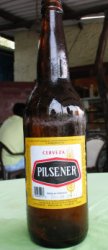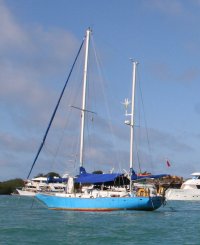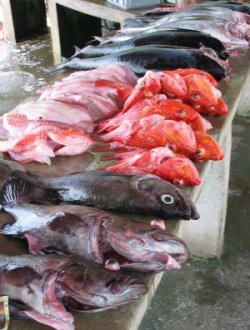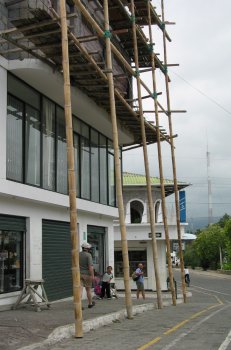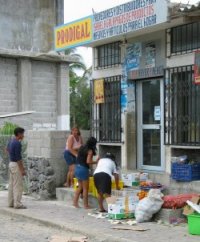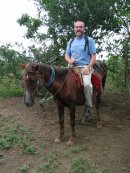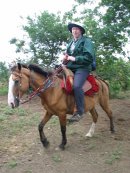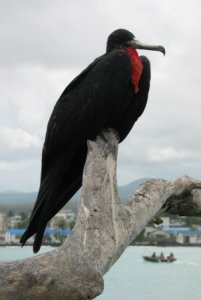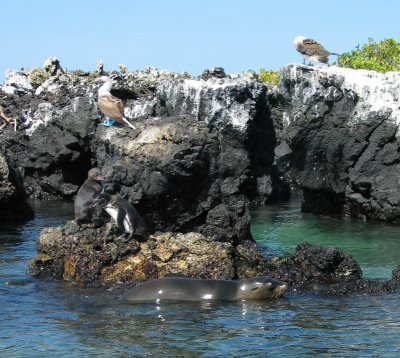 Galápagos
- May 2005
Galápagos
- May 2005
|
|
|
The thousand mile passage from Panama to the Galápagos Islands, part of Ecuador, took us 11 days. Winds were fairly light and we used almost all our diesel motoring through the calms, the Doldrums and against the current - thank goodness we had bought another 5 diesel containers in Panama! The Doldrums are an area around the equator notorious for windless conditions - we motored constantly for two days to cross them. Of course when we crossed the equator we had a wee celebration and gave Neptune a dram too! Ecuadorian beer comes in a generous one-pint-sized bottle! |
|
|
|
Tom celebrated his birthday during this passage - new toys include a t-shirt and hand-painted chess set with pieces resembling South American Indians and the Spanish Conquistadors. |
|
The Queen of the Indians. |
|
Red-Footed Booby on our mizzen mast. |
|
On checking our wee inflatable globe we were surprised to see that the Galápagos, at West 090°, are on the same longitude as New Orleans in the USA. Hawaii is much further out into the Pacific at West 156°. As we came closer to the islands, we started seeing some of the wildlife. Several Red-Footed Boobies flew around during the day and perched on the top of our mizzen mast for a sleep each night. While they slept, the "night shift" of Swallow-tailed Gulls fed around the bow, using the dim glow of our navigation lights to see their prey of small fish and squid. These are the only nocturnal gulls in the world and make a whirry-clicking noise thought to be used for echo-location.
|
|
We arrived at the island of Santa Cruz on 5th May and anchored off the main town (well the only town really) of Puerto Ayora. This is where the tour boats pick up their passengers, so by Galápagos standards, it's a busy wee place. We were there to pick up a passenger too - Tom's brother John flew in to join us for a couple of weeks.
|
Nechtan at anchor, Puerto Ayora. |
|
|
Looking east across Puerto Ayora. |
|
|
Getting ashore at Puerto Ayora is easy - just hail a passing water taxi - 50c each for the trip. The horrible swell sometimes made it a leap of faith! |
|
Volleyball is played every evening down on the waterfront and is very popular. |
|
The day's catch at the fish market. |
|
Bamboo scaffolding - allegedly very strong! |
|
A jewellery shop. |
|
The Galápagos seems to attract artists who like interesting shop fronts! These are all in Puerto Ayora. And just in case you don't see enough of the real ones, the town also boasts giant statues of some of the local critters. |
|
A tourist gift shop. |
|
Even the lamp post has been decorated! |
|
Giant Tortoise and friend. |
|
Wandering Albatross. |
|
A supply freighter.... |
|
...and some of the supplies it delivered. |
|
Galápagos Dove. |
|
The Galápagos islands are famous worldwide as the place that helped Charles Darwin to come up with his ideas on evolution. He visited here in 1835 on the survey ship HMS Beagle and found the geology and wildlife fascinating. So did we, 170 years later. The wildlife is still generally unafraid of humans, allowing you to get very close. In fact Darwin recorded that he caught a Galápagos Dove "for the pot" just by throwing his hat at it!
|
|
One of the great things about the Galápagos is that it still has 95% of its original pre-man quota of species, hence it is recognised as a National Park, Marine Reserve, Whale Sanctuary, Man and Biosphere Reserve and World Heritage Site. Unlike so many other places on Earth, in the Galápagos we can see the animals, plants and environment virtually as Charles Darwin saw them back in 1835!
|
|
Marine Iguanas - evil looking wee devils! |
Giant Tortoise - looks like an old man on the hunt for his false teeth! |
|
Sally Lightfoot Crab. |
Brown Pelican. |
|
Great Blue Heron. |
Land Iguanas are not much bonnier to look at than their marine namesakes! |
|
We were surprised to learn that Charles Darwin had really made a mess of some of his observations and collections. For example, he had failed to notice that there was a specific species of tortoise on each island until this was pointed out to him by the vice-governor of the Galápagos. He also believed that all the different kinds of finches that he had collected were just variants of a single species and not distinct species in their own right. Thankfully other collectors on board ship, namely the Captain Robert Fitzroy and the surgeon Simms Covington, had made meticulous collections. The finches were finally separated into 13 species, almost all identifiable by their beak shape, by John Gould in London (yet they are still collectively referred to as "Darwin's Finches"!!). It was only long after the voyage was over that Darwin finally started to realise that the finches were one of the finest examples of adaptive radiation - they had all developed from a single ancestor as a result of isolation and a relative lack of pressure from predators. Since Australian finches are all brightly coloured, Sue had expected Darwin's (Gould's??) Finches to be similarly so, but was disappointed - they are nearly all a very boring black, with little bits of white and grey if you are lucky. |
|
One of the more brightly coloured versions of finch! |
A finch with a seed-cracking beak. |
|
Yellow Warbler. |
Mocking Bird. |
|
We stayed on Santa Cruz for a few days, seeing the sights, including a walk through a massive lava tunnel. These tunnels are formed when subterranean rivers of lava run out of molten rock and the "river" drains out, leaving a tunnel that you can walk (and occasionally crawl) through. |
Lava Tunnel. |
|
On a walk to Tortuga Bay (Turtle Bay), we passed through some very dry and prickly vegetation to reach a beautiful expanse of white sand, marred by the presence of a heavy oil spill just reaching the shore! Thankfully no turtles were coming ashore to lay eggs just now. |
|
The walk to Tortuga Bay.
|
Oil spill in the water at Tortuga Bay. |
|
Ghost Crab with eyes on amazing retractable stalks. This crab is about 5cm across the shell.
|
Little balls of sand about 4mm diameter - all that's left of the Ghost Crab's dinner search for algal and animal detritus. |
|
We visited the Charles Darwin Research Station which runs a giant tortoise breeding program. It is also the home of Lonesome George, the last of the giant tortoises from the island of Pinta - a powerful and sad reminder of the fragility of the Galápagos ecosystem. Before the arrival of man, there were 14 distinct subspecies of tortoise: one on each of the 9 islands, and one around each of the 5 main volcanoes on the largest island, Isabela. Of these only 11 subspecies remain. When George dies it will be down to 10. |
|
|
One of the giant tortoises at the Charles Darwin Research Station. |
|
|
|
These 2 male tortoises were having a bit of a squabble. Apparently the winner is the one who gets his head higher in the air than the other, but they also seemed happy to bite each other given the chance! |
|
|
The Galápagos were a favourite stop for the old sailing ships, especially whalers. Giant tortoises were taken onboard, hundreds at a time, as fresh meat supplies. They were stacked upside down in the ships' holds like boulders and could live for up to a year without food or water. Luckily these days are past - the last person to be caught eating a giant tortoise (quite recently) was given 8 years in prison!
|
|
Given how easy they are to catch and how good they taste (reputedly!), it's only their isolation that saved them from extinction. Assuming no-one eats them, they can live to around 150 years.
|
A Giant Tortoise in the wild, Santa Cruz. (Thanks to John for this picture.) |
|
Our favourite cafe in Puerto Ayora: Cafe del Lago, where they even make icecream the old-fashioned way! |
In addition to seeing the sights, and like most other cruisers, our shore lives seem to revolve around shopping for food, doing the laundry and, our favourite, eating out! |
|
Next we sailed the 40 miles to the biggest and surprisingly the least-visited of the Galápagos islands - Isabela. It has a population of 1500 people, a lovely, sheltered anchorage at Puerto Villamil and some great things to see. |
|
A solar panel array supplied nearly all the needs of the Port Captain's office. Hooray for renewable energy resources!! |
|
We were surprised that the small village of Puerto Villamil had a discoteque! (Although we never heard it in use.) |
|
Tom and John at our favourite eaterie in Puerto Villamil: Restaurante El Encanto de la Pepa. |
|
One of the local shops. |
|
|
The boys walk down one of the busy main streets in Puerto Villamil. Note that it was just sand - the villagers do not want tarmac roads! |
|
|
While there we took a trip up to see the extinct Sierra Negra Volcano and it's nearby and far more recently active neighbour, Volcan Chico.
|
Moonscape of Volcan Chico. (Thanks to John for this picture.) |
|
Getting there involved a half hour drive by truck, followed by an hour and a half on horseback and finally an hour on foot. Neither Tom nor John had ever been on a horse before but having watched "Bonanza" on TV regularly as boys, it was nae bother! (Although I don't remember the episode where Hoss Cartwright had big plasters applied to each cheek of his chafed bum, like Tom did the day after!) |
|
|
The Three Amigos! |
|
|
|
The caldera of the Sierra Negra volcano is 11km wide - you can only see a small part of it here! |
|
|
Both the Galápag0s Cotton flower..... |
|
....and the Lance Leafed Darwin Bush are found on the slopes of the volcanoes. |
|
Thread Leafed Chaff Flower - one of the early colonisers of a lava flow. |
|
Western Galápagos Racer Snake - not so fast as he was run over in a street! |
|
While we were on Isabela, there was an eruption of the La Cumbre volcano on the neighbouring island of Fernandina. So we arranged a short flight over the volcano with the local inter-island air service. It cost us US$100 each but we were looking forward to spectacular views of spouting red-hot lava and massive lava flows. It turned out to be rather less spectacular than imagined (the lava here is not the spurty red sort), but still worth seeing. |
|
Our plane. |
A view into the caldera of Volcan La Cumbre, with fresh black pahoehoe lava oozing slowly from a new eruption on the edge of the cone. |
|
|
A dramatic view across the bay at Puerto Villamil. |
|
|
We didn't have to move from the boat to see much of the wildlife. Sealions and penguins regularly swam around us while Blue-footed Boobies and Frigatebirds fished nearby. |
|
Galápagos Penguins. |
Blue-footed Boobies - their feet really are bright blue and don't show up well in the photo. |
|
Sealions. |
Frigatebirds.
|
|
A 6 foot long White Tipped Reef Shark viewed from the safety of a ledge above. |
Looking out to the anchorage, Puerto Villamil, Isabela. |
|
For US$20 Francisco, Danilo and Juan brought more than 500 litres of fresh water out to us. |
John flew home and we sailed back to Puerto Ayora to buy fresh fruit and vegetables and fill up with water before the Pacific crossing. We cleared out with customs and immigration and headed back to Isabela to relax for a couple of days and do a few last minute jobs...as always!
|
|
One job we had been saving up to do for a while was to renew the sealant in the seams of the teak decking, as we were getting a few leaks. So we spent a day gouging out the old sealant and cleaning out the seams, happy in the knowledge that with 9 full tubes of Sikaflex onboard we had more than enough with which to do the job. Sadly we discovered that 7 of the tubes had gone hard. There was no marine sealant to be had in the Galápagos, and we'd had bad reports about the supplies in Ecuador, so we resorted to ordinary bathroom sealant. Colour? White. Oh dear, but at least it works....for the time being! |
Yes Sir! White and black deck seams are all the rage just now! |
|
Before we left we bought a big stalk of green bananas for US$5 from a local farmer. We followed the advice of other cruisers to soak it in the sea for 10 minutes before taking it onboard - this is to drown any beasties who would like to stowaway. Good job we did as a few swam out, including a Giant Huntsman Spider which was about 4 inches across (Sue doesn't like big spiders!) (Tom doesn't either when they're that big!!!).
|
Washing the bananas. |
|
Please make yourself at home on our solar panel, but no pooping please! |
|
|
We also arranged a farewell BBQ evening at the beach bar run by a local fisherman and his family. The crews of 6 yachts were there - Filia Venti, Dream Merchant, El Cordero, Tinto and Moana - all just about to head off for the Marquesas. We kept in touch by SSB radio with all of them on the long passage.
|
|
|
|
|
On the morning of our departure, we went snorkelling with the sealions in the bay. They are very friendly and often escorted our dinghy into the beach, jumping out of the water all around us. In the water they swam around us, inquisitive as usual until they realised we weren't much fun and couldn't really swim very well by their standards! It was a good way to end our visit to these islands. The wildlife here is unforgettable. Just after lunch on 29 May we upped anchor and headed out towards the Marquesas, about 3000 miles to the west, across the emptiest part of the Pacific.
|
Swimming with the sealions. |
|
|
Bluefooted Boobys, Galapagos Penguins and a Sealion who didn't want to be left out of the picture! |
|
